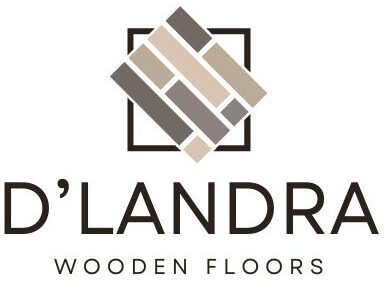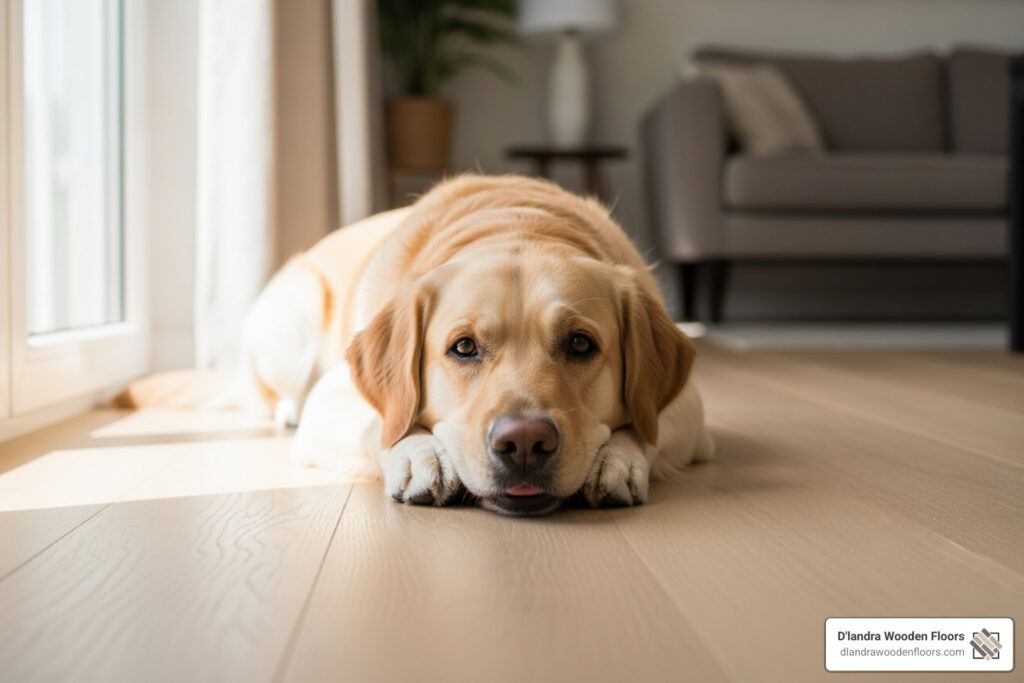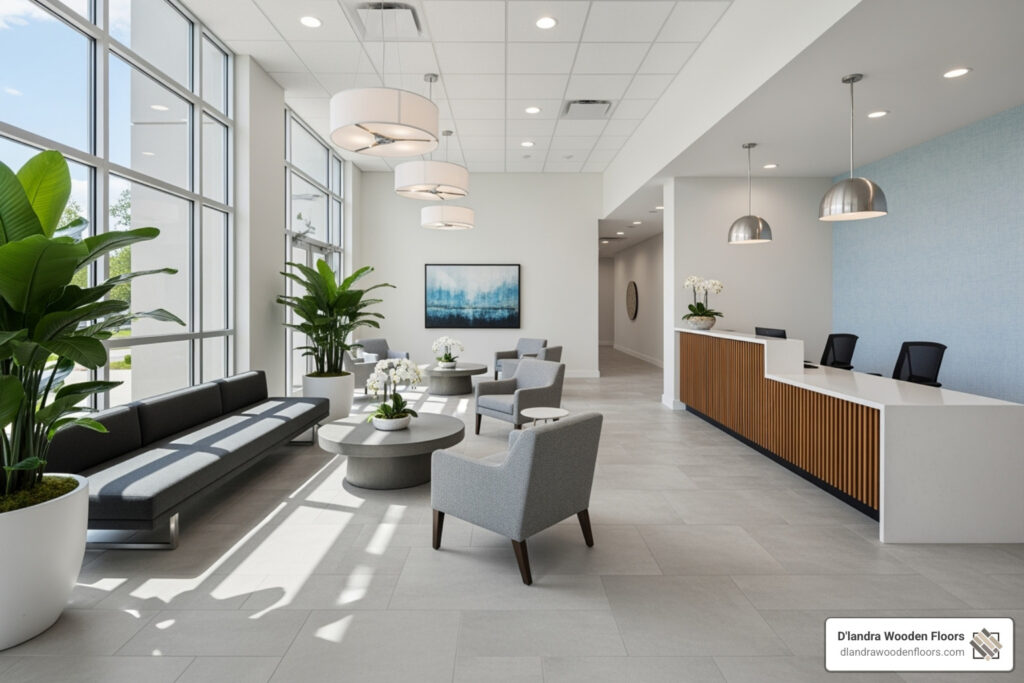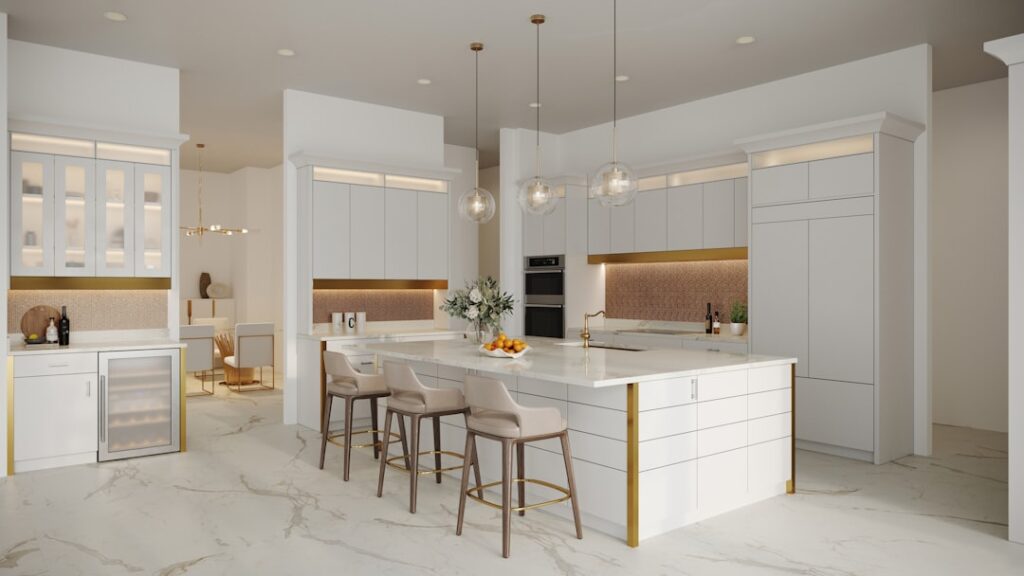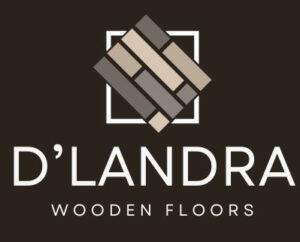Table of Contents
ToggleThe Evolution of Modern Vinyl Flooring: A Game-Changer in Home Design
Vinyl flooring advantages have made it one of the most popular flooring choices for homeowners in recent years. If you’re comparing flooring options, here’s what makes vinyl stand out:
- 100% waterproof construction (ideal for kitchens, bathrooms, basements)
- Durability with a lifespan of 10-25 years depending on quality
- Affordability at $2.50-$5 per square foot for materials
- Easy installation with DIY-friendly click-lock systems
- Low maintenance requiring only regular sweeping and occasional mopping
- Design versatility that convincingly mimics wood, stone, and tile
- Comfort underfoot with cushioned construction for warmth
Gone are the days when vinyl flooring was considered a budget-conscious compromise. Thanks to technological advancements, today’s vinyl flooring—especially luxury vinyl plank (LVP) and luxury vinyl tile (LVT)—offers an impressive combination of practicality and style that rivals traditional materials.
Modern vinyl is constructed of multiple layers including a rigid or flexible PVC core, a high-definition printed design layer, and a clear wear layer that protects against scratches, stains, and daily wear. This multi-layer construction creates a floor that’s not only durable but also comfortable underfoot and provides natural sound insulation.
“With advances in technology and innovation rapidly occurring, vinyl flooring products today are far superior to those produced even just two decades ago,” notes industry experts. This evolution has transformed vinyl from a basic utility flooring into a designer’s versatile tool.
For South Florida homeowners dealing with humidity, occasional water intrusion, and active lifestyles, vinyl offers particular advantages over traditional hardwood, which can warp in humid conditions, or ceramic tile, which can be uncomfortably cold and hard underfoot.
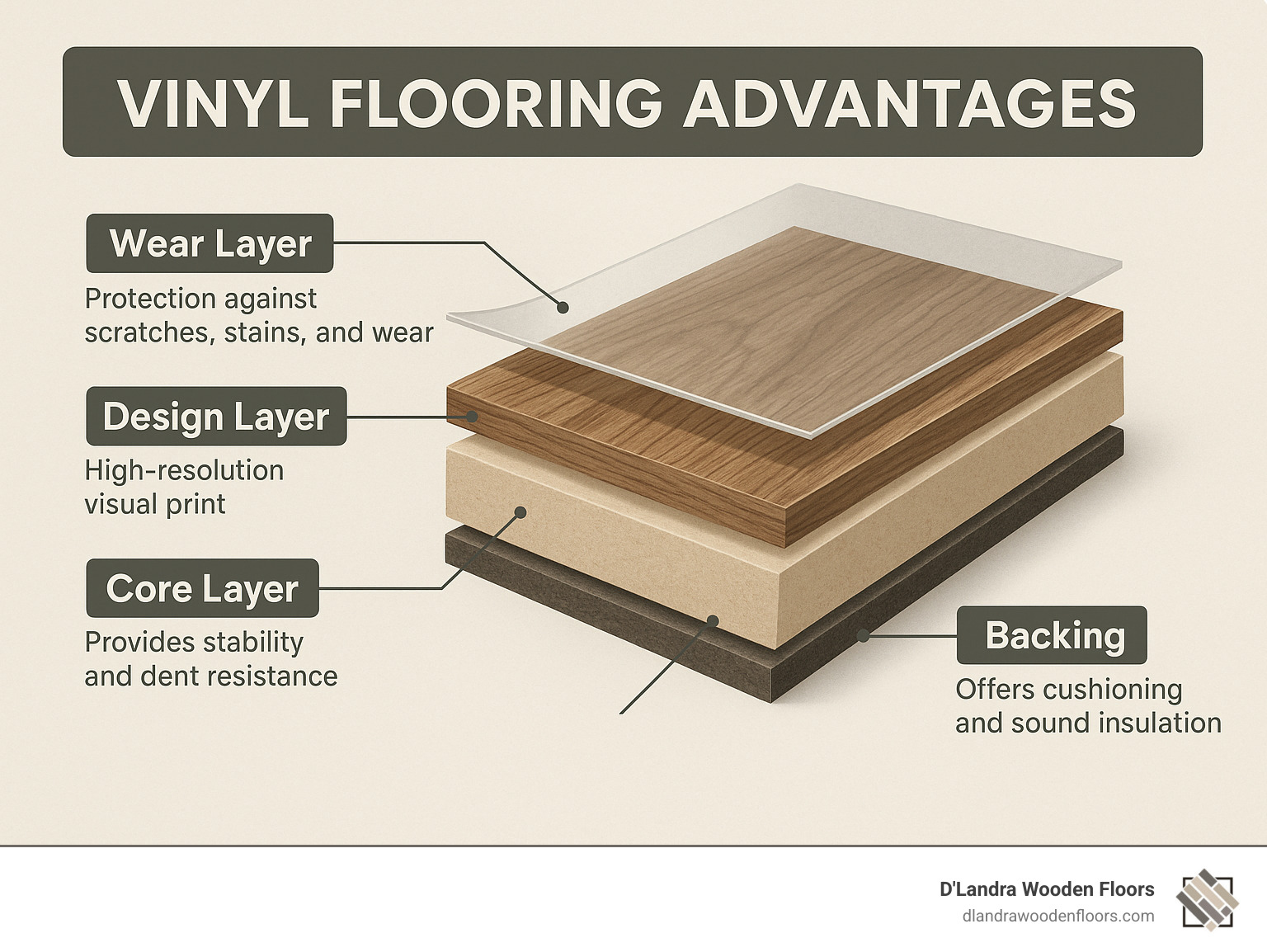
Top 10 Vinyl Flooring Advantages Every Homeowner Should Know
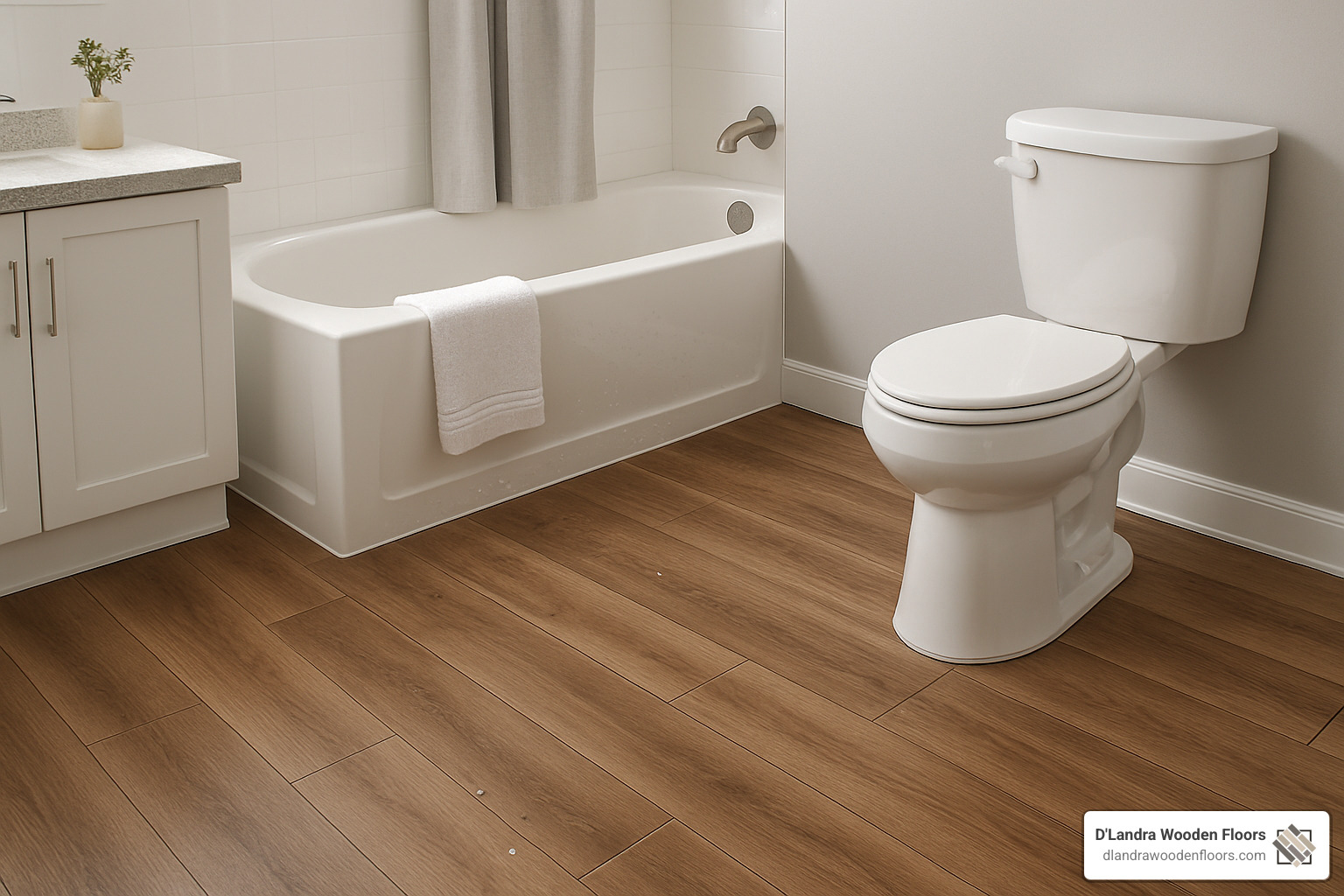
When our South Florida neighbors ask us about vinyl flooring advantages, the answer comes easily. Living in Coral Springs, Parkland, and throughout this region presents unique flooring challenges – from humidity to active lifestyles – and vinyl rises to meet them all. Let’s explore the ten remarkable benefits that make vinyl flooring such a popular choice for Florida homes.
Water Resistance: One of the Prime Vinyl Flooring Advantages
If you’ve ever dealt with water damage to traditional flooring, you’ll appreciate what might be vinyl’s greatest superpower: exceptional water resistance. Unlike hardwood that warps and swells when wet, vinyl stands firm against moisture.
“Vinyl sheet flooring is made of waterproof materials such as PVC,” as industry experts point out. This makes vinyl perfect for those splash-prone areas of your home – bathrooms where shower water escapes, kitchens where spills happen daily, and basements that might experience occasional moisture issues. For Florida homeowners facing high humidity and the occasional flood concern, this peace of mind is invaluable.
Modern luxury vinyl planks feature a 100% waterproof core that keeps water from seeping through to your subfloor. Even in sheet vinyl installations, properly sealed seams create a virtually impenetrable moisture barrier. This waterproof nature also prevents mold and mildew growth – a significant benefit in our humid South Florida climate.
With proper installation, your vinyl floors can withstand standing water for extended periods without damage. For families with young children, pets, or those who love to entertain, this means no more panicking over spilled drinks or pet accidents.
More info about Vinyl Flooring for Bathrooms
Design Variety: Aesthetic Vinyl Flooring Advantages for Any Décor

Remember when vinyl meant limited, obviously fake-looking patterns? Those days are long gone. Today’s vinyl is a designer’s dream with an incredible range of styles that convincingly mimic natural materials.
Wood-look vinyl captures everything from rustic oak to exotic teak, complete with realistic grain patterns and textured surfaces that feel remarkably like real wood underfoot. Stone-look vinyl beautifully replicates marble, slate, and travertine without the cold feel or high maintenance. Tile-look vinyl gives you the appearance of ceramic without those forever-dirty grout lines.
“It’s almost difficult to tell luxury vinyl from natural materials due to high-definition printing,” note flooring specialists. Today’s advanced printing techniques create depth, texture, and realism that was unimaginable just a decade ago.
The color options seem endless – from traditional wood tones to bold contemporary colors. You can even find vinyl with metallic finishes or abstract patterns for truly distinctive spaces. Installation patterns add another layer of design flexibility, with herringbone, chevron, and mixed-width installations all possible with vinyl planks.
For South Florida homeowners who love the look of hardwood but worry about humidity damage, wood-look vinyl delivers the perfect compromise – beautiful wood aesthetics with none of the climate concerns.
Built-In Durability & Lifespan
When it comes to standing up to real life, vinyl truly shines. Modern vinyl flooring is engineered to handle whatever your household dishes out.
Premium vinyl features wear layers measured in mils (thousandths of an inch), with thicknesses ranging from 6 to 30 mils. A 20-mil wear layer can withstand years of heavy traffic without showing signs of wear. Advanced technologies like “Diamond 10” infuse the wear layer with cultured diamonds for exceptional scratch resistance, while rigid core vinyl planks resist denting from heavy furniture and high heels.
“Vinyl flooring is highly durable and, if properly installed and maintained, can last upwards of ten to twenty years,” according to industry research. Many premium products come with warranties ranging from 15 years to lifetime residential use.
I recently visited a Parkland family with three children and two large dogs who installed luxury vinyl five years ago. Their floors still look nearly new despite daily abuse from toys, pet claws, and sports equipment. The same family had previously replaced engineered hardwood after just three years due to scratches and water damage.
For high-traffic areas like hallways and family rooms, vinyl’s durability makes it exceptionally practical. The extended service life and minimal maintenance requirements result in a lower cost of ownership over time – making vinyl not just a durable choice, but an economically sensible one too.
Easy Cleaning & Low Maintenance
For busy families, vinyl’s easy maintenance is a blessing. Unlike many flooring types that demand special cleaners or regular treatments, vinyl care is refreshingly simple.
Daily cleaning requires just a quick sweep or vacuum (without a beater bar) to remove surface dirt. Weekly, a damp mop with a mild cleaner keeps vinyl looking fresh. Spills? Just wipe them up – no sealing or special treatment needed.
“Use a broom, vacuum, or microfiber sweeper for regular cleaning; for deeper cleans, use a damp mop with a mild cleaner—no waxing required,” advises flooring experts. Unlike hardwood floors that may need periodic refinishing or carpets requiring professional cleaning, vinyl maintains its appearance with minimal effort.
The non-porous surface of vinyl naturally resists stains. Red wine, tomato sauce, and other common household spills that would permanently damage other flooring types can be easily wiped away from vinyl. This easy-care nature makes vinyl particularly valuable for rental properties, vacation homes, and households with young children or pets.
The hypoallergenic surface is another maintenance advantage. Unlike carpet that traps allergens, vinyl’s smooth surface doesn’t harbor dust mites, pet dander, or pollen. A simple cleaning removes these potential irritants, contributing to better indoor air quality.
Comfort, Warmth & Noise Reduction
Have you ever walked barefoot on tile floors in winter, then stepped onto vinyl? The difference in comfort is immediately apparent. Vinyl’s layered construction creates a more forgiving, comfortable surface underfoot.
“Vinyl helps maintain an even room temperature and feels comfortable underfoot,” note industry experts. This comfort comes from vinyl’s cushioned core, which provides natural resilience. The material’s thermal properties mean it doesn’t get as cold as tile or stone, maintaining a more consistent temperature year-round.
For South Florida homes with open floor plans, vinyl’s acoustic properties are particularly valuable. The sound-dampening effect reduces echoes and footfall noise, creating a quieter, more peaceful home environment. One Weston homeowner told me, “After replacing our tile floors with luxury vinyl, conversations became easier because we weren’t competing with echoes. The whole house feels more comfortable and quieter.”
Many vinyl products are also compatible with radiant heating systems, allowing for warm floors in winter without compromising the flooring’s integrity. For aging-in-place considerations, vinyl’s softer surface can reduce fatigue when standing for long periods and provides a more forgiving surface should falls occur – making it an excellent choice for multi-generational homes.
Scientific research on sound insulation
Budget-Friendly Without Sacrificing Style
One of the most compelling vinyl flooring advantages is its affordability. Vinyl delivers premium aesthetics and performance at a fraction of the cost of natural materials.
Material costs typically range from $2.50 to $5 per square foot for quality vinyl products, with professional installation running approximately $1-$3 per square foot. A complete vinyl flooring project often costs 30-50% less than comparable hardwood or tile.
To put this in perspective, a 500-square-foot space would cost approximately $1,750-$4,000 total with premium vinyl flooring (including installation). The same space with hardwood would run $5,500-$10,000, while ceramic tile would cost $5,000-$9,000.
“Vinyl is one of the most affordable flooring options, with material costs usually ranging from $2.50 to $5 per square foot,” confirms industry research. This affordability doesn’t mean compromising on quality or aesthetics. Today’s vinyl can convincingly mimic materials costing three to five times as much.
The savings extend beyond initial purchase. With minimal maintenance requirements and excellent durability, vinyl doesn’t incur the ongoing expenses associated with carpet cleaning, hardwood refinishing, or tile grout sealing. For South Florida homeowners looking to maximize their renovation budget without sacrificing style or performance, vinyl offers unbeatable value.
DIY-Friendly Installation Options
While we always recommend professional installation for the best results, vinyl’s DIY-friendly nature is a significant advantage for handy homeowners. Several installation methods make vinyl accessible to ambitious DIYers:
Click-lock floating systems snap together without adhesives, creating a floor that “floats” over the subfloor. Peel-and-stick tiles apply directly to a properly prepared subfloor with self-adhesive backing. For spaces up to 50 m², loose-lay sheet vinyl can be installed with just perimeter tape.
“Vinyl installation can be straightforward,” notes flooring experts, though they caution that “achieving long-term durability requires perfect installation.”
A successful DIY vinyl installation requires proper subfloor preparation – it must be clean, flat, smooth, dry, and structurally sound. Imperfections will show through vinyl, so taking time with this step is crucial.
One South Florida homeowner shared, “I installed click-lock vinyl planks in my guest bedroom over a weekend. The most time-consuming part was preparing the subfloor, but the actual installation went quickly once I got the hang of it.”
For those who prefer professional installation, the process is typically faster and less disruptive than hardwood or tile installation. Many vinyl products can be installed in a single day, minimizing household disruption.
Subfloor Versatility & Over-Floor Installs
Another remarkable vinyl flooring advantage is its flexibility regarding subfloor requirements and the ability to install over existing flooring in many cases.
“In many cases, vinyl can be installed over existing hard surfaces like concrete, tile or wood if the surface is smooth and even,” explains flooring professionals. This versatility makes vinyl an excellent choice for renovations where removing existing flooring would be costly or disruptive.
Vinyl can be successfully installed over concrete slabs (with proper moisture testing and barriers), plywood or OSB subfloors, existing vinyl flooring (if in good condition), existing ceramic tile (with proper preparation), and even some hardwood floors depending on their condition.
This flexibility saves significant time and money during renovations. Removing existing flooring and disposing of it can add thousands to a project’s cost and days or weeks to the timeline.
For concrete subfloors common in South Florida homes, vinyl offers particular advantages. Unlike hardwood, which requires special installation methods over concrete, vinyl can be directly installed with appropriate moisture barriers. This makes vinyl ideal for slab-on-grade construction typical in our region.
A moisture barrier is essential for most vinyl installations in South Florida due to our high humidity. This barrier prevents moisture from migrating up through concrete slabs and causing problems with the flooring.
Family- & Pet-Proof Performance
For households with children and pets, vinyl flooring offers peace of mind that few other flooring options can match. High-quality vinyl resists scratches from pet claws and toys, while its stain-resistant surface means accidents and spills clean up easily without leaving permanent marks.
Many vinyl products offer textured surfaces for improved traction, reducing slip hazards for both two-legged and four-legged family members. Vinyl’s softer surface also dampens the sound of running feet and pet nails – something your neighbors (or your own ears) will appreciate.
“Vinyl flooring is durable, easy to clean, and pet-friendly; consider a pet-specific collection for extra scratch resistance,” advises industry experts.
A Weston family with three large dogs told me, “After years of constantly refinishing our hardwood floors due to pet scratches, we switched to luxury vinyl planks. Five years later, the floors still look great despite daily abuse from 200+ pounds of energetic dogs.”
For families with young children, vinyl’s forgiving surface is gentler for crawling babies and toddlers learning to walk. Dropped toys are less likely to break, and falls are slightly cushioned compared to harder surfaces like tile.
Health-conscious families appreciate that many modern vinyl products are certified low-VOC and phthalate-free. Look for FloorScore certification, which indicates the product has been independently tested for chemical emissions and meets strict indoor air quality standards.
Fade & Sunlight Protection Strategies
While vinyl offers excellent durability against most forms of wear, Florida’s abundant sunshine presents a challenge. Prolonged exposure to direct sunlight can potentially cause fading over time. Fortunately, modern vinyl has significantly improved in this area, and there are effective strategies to protect your investment.
Many premium vinyl products now include UV-resistant coatings in their wear layers. Window treatments like blinds, curtains, or UV-filtering window film can significantly reduce direct sunlight exposure. Periodically moving area rugs prevents uneven fading, while occasionally changing your room layout helps ensure even exposure.
“Excessive direct sunlight can fade vinyl flooring over time, so window treatments may be needed,” notes industry research. This is particularly relevant in sunny South Florida, where homes often feature large windows and abundant natural light.
When selecting vinyl flooring, review the warranty information regarding fade resistance. Premium products typically offer better protection against UV damage and may have specific warranty coverage for fading.
One Coral Springs homeowner found a creative solution: “We installed UV-filtering film on our south-facing windows. It’s nearly invisible but blocks 99% of UV rays, protecting both our vinyl floors and furniture from fading.”
For outdoor-adjacent spaces like Florida rooms or covered patios, look for vinyl specifically rated for indoor/outdoor use or with improved UV protection. With proper precautions, today’s vinyl flooring can maintain its appearance for many years, even in our sunshine-filled South Florida homes.
More info about Vinyl Plank Flooring Advantages
Head-to-Head: Vinyl vs. Hardwood, Tile, Laminate & Carpet
Wondering how vinyl truly compares to other popular flooring options? Let’s put them side by side to see where the vinyl flooring advantages really shine in everyday situations:
| Feature | Vinyl | Hardwood | Ceramic Tile | Laminate | Carpet |
|---|---|---|---|---|---|
| Cost (materials) | $2.50-$5/sq ft | $5-$15/sq ft | $5-$10/sq ft | $1-$5/sq ft | $2-$7/sq ft |
| Installation Cost | $1-$3/sq ft | $4-$8/sq ft | $5-$10/sq ft | $2-$5/sq ft | $1-$3/sq ft |
| Water Resistance | Excellent | Poor | Excellent | Fair | Poor |
| Durability | 10-25 years | 30+ years with refinishing | 50+ years | 10-15 years | 5-15 years |
| Comfort Underfoot | Good | Moderate | Poor | Moderate | Excellent |
| DIY Installation | Easy-Moderate | Difficult | Difficult | Moderate | Difficult |
| Maintenance | Very Easy | Moderate | Moderate | Easy | Difficult |
| Sound Insulation | Good | Poor | Poor | Poor | Excellent |
| Heat Compatibility | Good | Limited | Excellent | Limited | Poor |
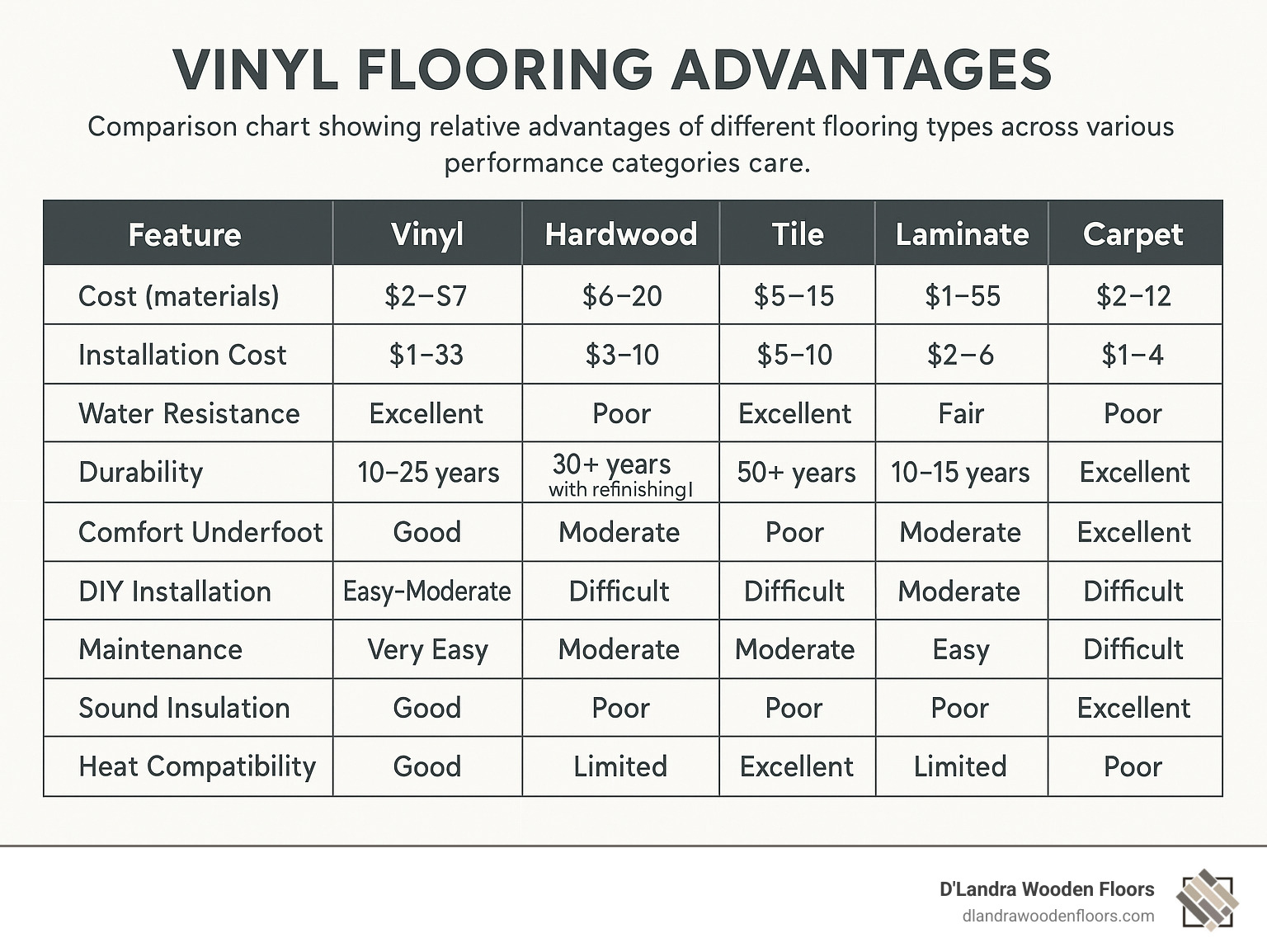
Durability & Lifespan Face-Off
When it comes to how long your floors will last, each material tells a different story:
Vinyl flooring offers a solid 10-25 year lifespan, with quality and wear layer thickness being the key factors. What I love about vinyl is its consistency—it performs reliably throughout its life without needing refinishing. When it eventually wears out, you’ll need a complete replacement, but that’s typically after a decade or two of faithful service.
Hardwood certainly wins the longevity contest on paper. With proper care, it can last 30+ years and can be refinished multiple times. I’ve seen century-old hardwood floors that still look gorgeous after professional restoration. The downside? Hardwood shows its age in high-traffic areas and can be permanently damaged by water—a real concern here in humid South Florida.
Ceramic tile is practically the marathon runner of flooring, often lasting 50+ years. It’s incredibly durable, though individual tiles can crack from dropped heavy objects. The grout becomes the maintenance headache, requiring regular cleaning and occasional resealing.
Laminate typically offers a 10-15 year run before showing significant wear. Unlike hardwood, it can’t be refinished, and edge swelling from moisture exposure is a common issue that can’t be repaired—only replaced.
As one Coral Springs homeowner told me: “We installed vinyl in our rental property five years ago. Despite tenants coming and going, it still looks nearly new. Our previous laminate would have been destroyed by now.”
Installation & DIY Difficulty
The installation experience varies dramatically between flooring types, especially if you’re considering the DIY route:
Vinyl flooring has become the darling of the DIY world with its click-lock systems that snap together without adhesives. Most moderately handy homeowners can install a vinyl floor in a weekend with basic tools. The subfloor prep is actually the most crucial and time-consuming part of the job.
In contrast, hardwood flooring installation is not for the faint of heart. It requires specialized equipment for nail-down or glue-down methods, precise cutting skills, and proper acclimation of the wood. Even small mistakes can lead to squeaky boards or uneven surfaces.
Ceramic tile might be the Mt. Everest of DIY flooring projects. The precision required for proper tile spacing, the specialized cutting tools, and the finicky nature of grout work makes this best left to professionals for most homeowners. I’ve seen too many DIY tile jobs that looked amateur from day one.
Laminate flooring falls somewhere in the middle difficulty-wise. It uses a similar floating installation to click-lock vinyl but is less forgiving of subfloor imperfections and can be more challenging to cut properly.
“I attempted to install tile in my bathroom and gave up halfway through,” confessed one Parkland homeowner. “I called professionals to finish the job and they basically had to start over. For my kitchen, I installed vinyl myself and it turned out beautifully on the first try.”
Cost & Value Analysis
Let’s talk dollars and sense when comparing these flooring options:
For a typical 500 square foot project, vinyl will set you back about $1,750-$4,000 total, including materials and installation. Hardwood jumps significantly to $4,500-$11,500, while ceramic tile ranges from $5,000-$10,000. Laminate and carpet are more comparable to vinyl at $1,500-$5,000.
But initial cost isn’t the whole story. Hardwood flooring typically adds the most value to your home at resale time. Real estate agents consistently report that hardwood floors help homes sell faster and for higher prices. However, in South Florida’s humid climate, potential buyers increasingly understand the practical advantages of quality vinyl.
Ceramic tile offers excellent value when you consider cost-per-year over its extremely long lifespan. That $8,000 tile floor that lasts 50 years costs you just $160 per year, compared to a $3,000 vinyl floor lasting 15 years at $200 per year.
Vinyl flooring shines when you consider the performance-to-price ratio. You’re getting excellent water resistance, durability, and style at a fraction of the cost of natural materials. For young families, rental properties, or homes in flood-prone areas, this value proposition is particularly compelling.
A local real estate agent recently shared: “Five years ago, I’d advise sellers to replace vinyl with hardwood before listing. Now, I often recommend high-quality vinyl, especially in South Florida. Buyers recognize the practical benefits and it helps sellers keep renovation costs manageable.”
Environmental & Air-Quality Considerations
The environmental impact of your flooring choice deserves careful consideration:
Vinyl flooring has traditionally been the least eco-friendly option, being made from PVC, a petroleum product. However, the industry has made significant strides in recent years. Today’s premium vinyl products often feature phthalate-free formulations and low VOC emissions. Look for FloorScore or GREENGUARD certification to ensure better indoor air quality. While vinyl isn’t biodegradable, some manufacturers now offer recycling programs.
Hardwood flooring boasts impressive environmental credentials when sourced responsibly. It’s a renewable resource, especially with FSC certification ensuring sustainable forest management. The natural material undergoes minimal processing compared to synthetic options, though the finishes can emit VOCs during and after installation.
Ceramic tile is made from natural clay and minerals, creating an inert material that doesn’t off-gas. Its environmental downsides include an energy-intensive manufacturing process and heavy weight that increases transportation emissions. However, its extremely long lifespan means less frequent replacement and waste.
Laminate flooring contains wood byproducts and resin, potentially emitting formaldehyde and other VOCs. Look for CARB2 compliance for lower emissions. Its shorter lifespan means more frequent replacement and waste.
A mother in Weston shared: “After my son developed asthma, we replaced our old carpet with phthalate-free vinyl that had GREENGUARD certification. His symptoms improved noticeably within weeks, and I appreciate that we didn’t have to sacrifice style for health.”
When selecting vinyl, prioritize products with these environmental certifications for peace of mind about what you’re bringing into your home.
Scientific research on vinyl phthalates
Maintenance & Cleaning Showdown
The ongoing maintenance required for different flooring types can significantly impact your everyday life:
Vinyl flooring is the clear winner in the low-maintenance category. A quick sweep or vacuum (without a beater bar) handles daily cleanup, while a weekly damp mop with mild cleaner keeps things fresh. Spills and stains wipe away easily without special treatments. There’s no waxing, polishing, or refinishing needed throughout its life—a true “install and forget” option that’s perfect for busy households.
Hardwood flooring demands more attention. Beyond daily sweeping and weekly vacuuming with a hardwood attachment, you’ll need monthly cleaning with special hardwood cleaners. Spills require immediate attention to prevent staining or warping. Every 3-5 years, plan on screen and recoat maintenance, with full sanding and refinishing every 10-20 years—processes that are disruptive and costly.
Ceramic tile looks gorgeous but hides a maintenance secret: grout. While the tile itself is easy to clean, grout lines require regular scrubbing to prevent staining and mildew, especially in our humid South Florida climate. Expect to reseal grout every 1-2 years to maintain its appearance and water resistance.
Laminate flooring requires careful moisture management. You’ll need to sweep or dust mop regularly and use only a slightly damp (never wet) mop for deeper cleaning. Excess moisture can cause edge swelling that can’t be repaired, only replaced.
“I spent years babying my hardwood floors,” laughed one Parkland mother of three. “After switching to vinyl, I actually enjoy having the kids and dog run in from the pool without having a panic attack about water damage. Life’s too short to stress about floors!”
Where Each Floor Excels: Room-by-Room Guide
Each flooring type has its sweet spot in the home where its unique properties shine brightest:
In bathrooms, vinyl and ceramic tile reign supreme due to their excellent water resistance. Vinyl flooring advantages are particularly notable here—it’s 100% waterproof like tile but warmer underfoot and available with slip-resistant textures for safety. For South Florida’s humid bathrooms, vinyl provides peace of mind against moisture issues while remaining comfortable on bare feet.
Kitchens benefit from vinyl’s perfect combination of water resistance, comfort for long cooking sessions, and easy cleanability. While ceramic tile and properly sealed hardwood can work well too, vinyl offers the best all-around performance, standing up to dropped pots, spilled liquids, and high traffic without complaint.
For living rooms, hardwood has traditionally been the premium choice, but vinyl is quickly gaining ground. Today’s luxury vinyl offers the wood-look aesthetics many homeowners desire with added benefits of sound absorption (perfect for open floor plans) and superior durability for high-traffic areas.
In bedrooms, comfort becomes paramount. While carpet has traditionally dominated this space, vinyl’s hypoallergenic properties make it an excellent choice for allergy sufferers. It’s quieter underfoot than hardwood or tile and maintains a comfortable temperature year-round.
Basements present unique challenges that vinyl handles beautifully. Its moisture resistance prevents the mold and mildew issues that can plague carpet and hardwood in below-grade installations. Vinyl also feels warmer than tile, making basement living spaces more comfortable.
For Florida rooms and sunrooms that receive abundant natural light, UV-resistant vinyl provides the durability needed against sun exposure while remaining comfortable for the indoor-outdoor lifestyle so common in South Florida homes.
“We’ve installed every type of flooring over 25 years in business,” shared a local contractor. “In South Florida’s climate, vinyl simply performs better in most rooms, especially where moisture, sunlight, and active lifestyles intersect—which is pretty much everywhere in Florida homes.”
More info about Waterproof Flooring for Kitchens
Conclusion & Next Steps

As we wrap up our look at vinyl flooring advantages, it’s easy to see why so many South Florida homeowners are choosing this modern flooring solution. Vinyl has come a long way from its humble beginnings—now it’s a top choice for families who want durability, comfort, and style, without breaking the bank.
For our unique South Florida climate, vinyl flooring truly shines. Its water and humidity resistance means it stands up to pool splashes, sandy feet, and even the occasional tropical downpour that sneaks inside. The comfort underfoot is especially nice for our year-round barefoot lifestyle—no more hopping across cold, hard tile on the way to your morning coffee.
But what really sets vinyl apart is how it manages to blend practicality and beauty. It’s tough enough to handle kids, pets, and busy schedules, yet stylish enough to impress your guests. Cleaning is a breeze (goodbye, weekend floor marathons!), and with so many design options, you can find the perfect look for any room. All this, and it’s still one of the most affordable flooring choices on the market.
Of course, every flooring material has its strengths, but vinyl’s winning combination of affordability, resilience, and design variety makes it a smart choice for many spaces—from kitchens and bathrooms to living rooms and bedrooms. Whether you’re taking on a full remodel or just freshening up a single room, vinyl should definitely be on your shortlist.
At D’Landra Wooden Floors, our mission is simple: deliver floors that you’ll love for years to come. That means precision installations, premium products, and customer service that treats you like family (awkward family dinners not included!). We serve Coral Springs, Parkland, Weston, and all of South Florida, and our team is fully insured for your peace of mind.
Curious about your options? We offer free in-home estimates and expert advice to guide you every step of the way—from choosing the right style to a flawless, worry-free installation. Our process is straightforward and designed to make your flooring journey as smooth as possible.
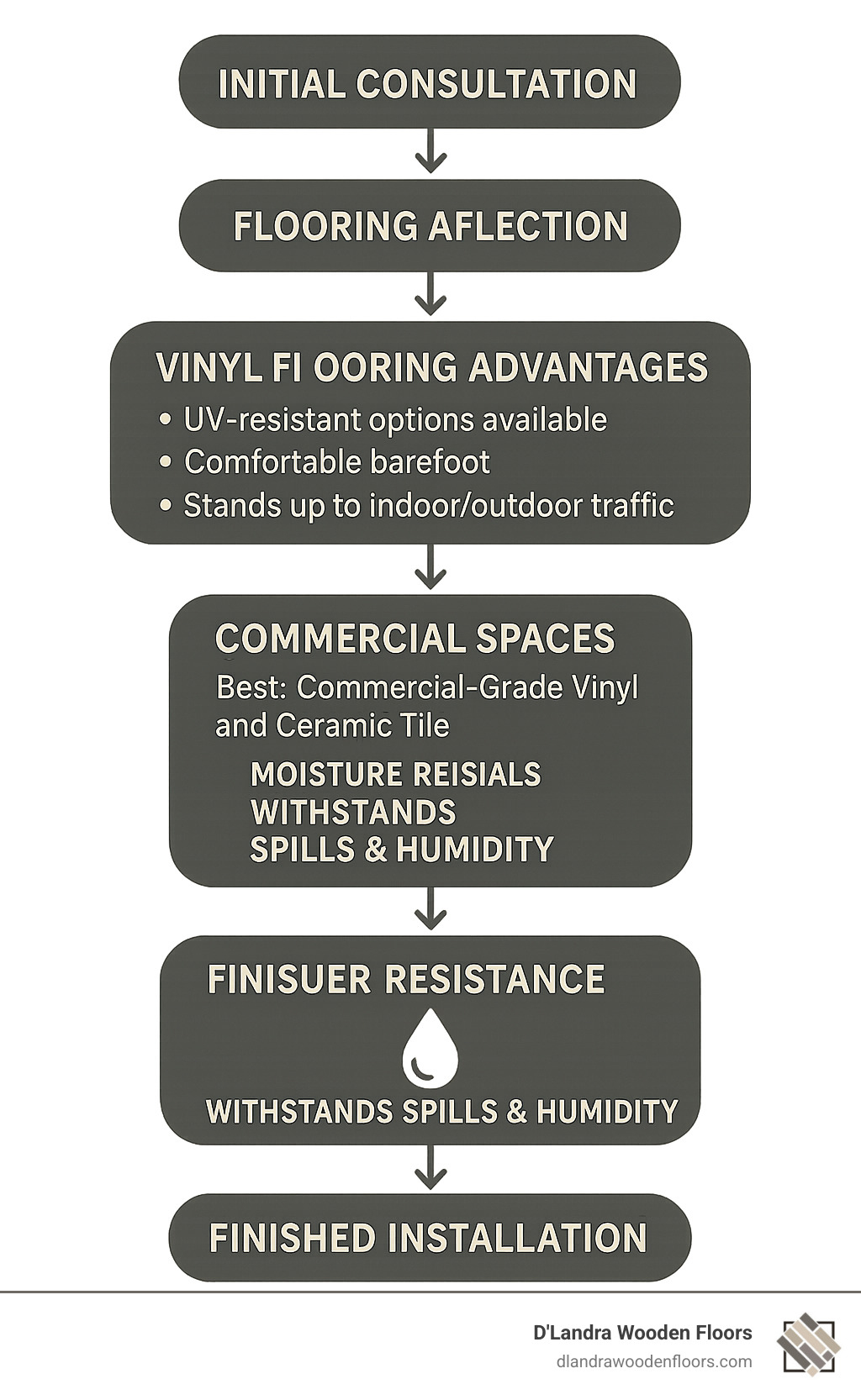
It’s truly remarkable how vinyl flooring advantages have transformed what used to be a “budget” option into a premium, long-lasting flooring solution. And with new designs and technologies arriving every year, the future of vinyl is looking even brighter.
Ready to see these benefits for yourself? We invite you to visit our showroom, or schedule an in-home consultation with our friendly team. Let’s help you find the perfect floor for your lifestyle, your home, and your budget.
And if you’re also considering hardwood, we handle that too—learn more about our hardwood installation services.
Your dream floors are just a call or click away. We can’t wait to help you bring them home!
